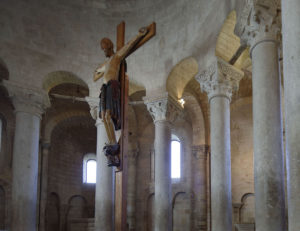
Along the old pilgrimage road linking Rome to Santiago de Compostela (Spain), a few miles south of the medieval town of Montalcino stands the old Abbey Church of Sant’Antimo, surrounded by fields and olive groves, which offers special tours and Easter liturgy week liturgy sung by Benedictine monks.
Sant’Antimo welcomes visitors and pilgrims alike, offering a unique cultural and religious experience.
There are two guided visits offered, “Via della Luce” and “Via del Silenzio”, in English meaning the way of light and the way of silence. “Via delle Luce” is a tour on the inside of the church, while Via del Silenzio will visit the green spaces outside the Abbey, including the monastic garden of aromatic herbs and medicinal plants. Admission is €6; visit www.antimo.it for more information.
During the Holy Week of Easter, there will masses and religious celebrations on Good Friday at 6 pm, Holy Saturday at 8:30 pm and Easter Sunday at 11 am. All of the ceremonies will be held with Gregorian chant.a
ARCHITECTURE
A single cypress soars up beside the solid Lombard-style bell tower. The landscape here is neither harsh nor gentle − as if extremes had been muted to allow the spirit of the place to emanate in all its subtlety.
Despite its rustic appearance, a discerning visitor will immediately recognize Sant’Antimo as a fine example of the Romanesque architectural style that flourished along the pilgrimage roads of Western Europe, and was distinguished from earlier styles for its considerable technical complexities, profuse ornament and use of high quality building materials. Like similar buildings in Germany, France and northwestern Spain, Sant’Antimo boasts a pilgrimage choir, compromising apse, ambulatory and radiating chapels. The church is further enriched by a number of art treasures.
The hills surrounding Sant’Antimo contain alabaster, travertine and onyx as well. These precious materials were used by the builders as construction materials for the church. Admittedly, it is not easy to imagine a country church incorporating solid blocks of abalaster and onyx in its walls; yet this is precisely the case.
To gain a full appreciation of the church, founded in 1118 A.D., visitors should wander in the ambulatory behind the high altar, taking note of the splendid time-worn smoothness of the stone slabs. Ask one of the clerics on duty to shine an electric torch on the wall or on a column, and marvel when you see the light penetrate deep inside, revealing the typical honey colored transparency of these noble materials. Better still, go in the morning when the sun from the east illuminates the alabaster and onyx in a dazzling burst of light.








